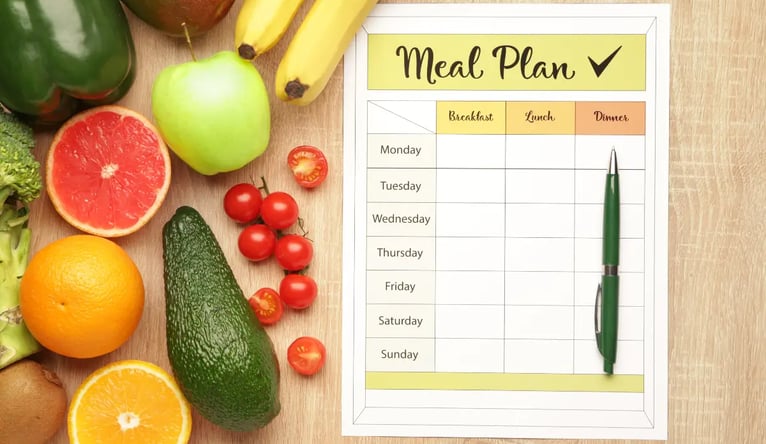
How to Write and Plan Your Meals Effectively for a Balanced Diet
Once you know the basics of nutrition, learn how to craft a solid meal plan. This step teaches you the strategies for organizing your weekly menu with clear, actionable steps.
MEAL PREP PLANNING
Mae Ellison
2/26/20255 min read


How to Write and Plan Your Meals Effectively
Meal planning is a game-changer when it comes to saving time, reducing stress, and making healthier food choices. Whether you're a busy professional, a parent, or someone looking to stay on track with your nutrition goals, planning your meals effectively can make all the difference. In this guide, we’ll walk you through the process of meal planning from start to finish, providing practical tips and strategies to help you stay organized and eat better every day.
Why Meal Planning is Essential for Healthy Living
Meal planning isn’t just about organizing your food for the week—it’s about creating a structure that supports a balanced lifestyle. From saving time to achieving specific nutritional goals, meal planning can simplify your life and ensure you’re consistently making healthy choices.
Essential Tools for Effective Meal Planning
To make your meal planning journey easier and more efficient, there are several tools that can help you stay organized. From apps to physical tools, the right resources will set you up for success.
Meal Planning Apps and Tools
Using meal planning apps can simplify the meal-planning process. These apps not only allow you to track your nutrition but also provide recipe suggestions based on your dietary preferences and goals. Many apps offer customizable meal plans, shopping lists, and even nutritional breakdowns to help you stay on track.
Grocery List Templates
A well-organized grocery list is key to staying on track. Using templates—whether physical or digital like Google Sheets—helps ensure you don’t miss any ingredients. You can group items by food category, making your shopping trip quicker and more efficient.
Meal Prep Containers and Storage Solutions
Investing in quality meal prep containers helps with organization and portion control. These containers ensure your prepped meals stay fresh and ready to eat, reducing food waste and encouraging consistency. Opt for glass containers or BPA-free plastic, and be sure to choose a variety of sizes to suit different meal types.
How to Write Your Meal Plan: A Step-by-Step Guide
Writing a meal plan doesn’t have to be complicated. With a little structure and some planning, you can set up a system that works for your goals, time, and lifestyle. Here’s a simple step-by-step guide to help you get started.
Set Clear Goals for Your Meal Plan
Before you start writing your meal plan, it’s important to define what you want to achieve. Are you looking to eat healthier, save time, or stick to a budget? Identifying your primary goal will help you make better decisions about what meals to include in your plan.
Health Goals: If you want to improve your nutrition or lose weight, prioritize meals rich in lean protein, vegetables, and whole grains.
Budgeting: If your focus is on saving money, plan meals that use affordable ingredients and make the most out of leftovers.
Time Management: If you're looking to save time, focus on simple recipes or batch-cooking meals that can be enjoyed throughout the week.
Create a Weekly Meal Schedule
Once your goals are set, it’s time to organize your meals for the week. A structured meal schedule makes it easier to follow through and avoid last-minute decisions. Here’s how to create your plan:
Designate Meal Categories: Decide on what meals you’ll need each day—breakfast, lunch, dinner, and snacks. This ensures you’re planning for the entire day and not leaving anything out.
Plan for Leftovers: Opt for meals that will provide leftovers. This reduces the number of times you’ll need to cook throughout the week and saves time.
Incorporate Variety: Keep your meals exciting by adding variety. Use different protein sources, vegetables, and grains to create a balanced diet that doesn’t feel repetitive.
Organize Your Grocery List
With your meal plan ready, it’s time to turn it into a shopping list. The better organized your list is, the quicker and easier your grocery shopping will be. Here are a few tips for an efficient list:
Group Ingredients by Category: Sort your grocery list by sections (e.g., produce, dairy, grains, meats). This will help you shop more efficiently and avoid unnecessary trips back to the store.
Stick to the Plan: Avoid impulse buys. Staying focused on your list will help you save money and prevent over-purchasing ingredients you don’t need.
Consider Batch Ingredients: If you’re planning to batch cook, purchase ingredients in bulk (like rice, beans, and veggies) that can be used in multiple meals throughout the week.
Prep Your Meals in Advance
Meal prepping is one of the most effective ways to stick to your plan. By prepping your meals ahead of time, you’ll have healthy options ready to go, even on your busiest days. Here’s how to do it:
Batch Cook: Cook large portions of staple ingredients like rice, quinoa, chicken, or roasted vegetables. These can be used in different meals throughout the week, saving you time.
Portion Control: Use containers to portion out meals in advance. This ensures you have the right serving sizes and reduces the temptation to overeat.
Snack Preparation: Pre-portion snacks such as nuts, fruit, or veggies. Having them ready to grab when you’re hungry will prevent you from reaching for unhealthy options.
Meal Planning for Different Diets and Preferences
Everyone’s dietary needs are unique. Whether you follow a specific diet or are planning meals for your family, meal planning can be adjusted to fit any preference.
Meal Planning for Special Diets
If you follow a specific diet—such as Mediterranean Diet, Keto Diet, Gluten-Free Diet, FODMAP Diet, CICO Diet, Diabetic Diet, or Atkins Diet—meal planning is even more crucial. It allows you to ensure that your meals are properly balanced and meet your nutritional requirements.
Mediterranean Diet: Focus on meals rich in healthy fats, whole grains, and lean proteins like fish, olive oil, and nuts.
Keto Diet: Emphasize high-fat, low-carb meals with plenty of meats, cheeses, and low-carb vegetables.
Gluten-Free Diet: Choose naturally gluten-free foods like quinoa, rice, potatoes, and gluten-free grains and flours.
FODMAP Diet: Eliminate high-FODMAP foods like onions and certain beans, focusing on easier-to-digest options.
CICO Diet: Focus on calories in vs. calories out, planning meals to fit within your daily caloric limit while still providing balanced nutrition.
Diabetic Diet: Plan meals around low-glycemic index foods, lean proteins, and fiber-rich vegetables to help regulate blood sugar levels.
Atkins Diet: Stick to low-carb, high-protein meals, especially during the induction phase, to promote fat burning.
Family Meal Planning
Meal planning for families can be tricky, especially when different family members have different tastes and dietary needs. Here’s how to make it easier:
Family-Friendly Meals: Opt for versatile dishes that can be customized for everyone. For example, make a taco night with different fillings so everyone can choose what they like.
Batch Cooking: Cook large quantities of meals that can be enjoyed by the whole family, and freeze any extras for future use.
Healthy Alternatives: If your kids love comfort food, find healthier versions. Swap regular pasta for zucchini noodles or use cauliflower rice instead of white rice.
Common Meal Planning Mistakes to Avoid
Even the most seasoned meal planners make mistakes now and then. Below are some typical mistakes people make and tips for steering clear of them:
Overcomplicating Your Meal Plan
While it’s tempting to plan elaborate meals, simplicity often works best. Overcomplicating your plan can lead to burnout. Stick to easy-to-make meals that you can prepare in 30 minutes or less.
Skipping Grocery Shopping or Prep Time
If you skip the shopping or meal prep step, your plan is likely to fall apart. Make sure to follow through with the preparation phase so you’re always ready for the week ahead.
Not Adjusting Plans Based on Lifestyle
It’s important to remain flexible with your meal plan. If your schedule changes, or you don’t feel like eating what you planned, it’s okay to swap meals around. Flexibility helps you stick to your plan without stress.
Conclusion
Writing and planning your meals effectively doesn’t have to be overwhelming. By setting clear goals, creating a manageable schedule, and sticking to a grocery list, you can make meal planning an easy and enjoyable habit. Whether you’re aiming for better health, saving time, or reducing stress, effective meal planning is the key to making healthy eating a consistent part of your lifestyle. Start small, stay organized, and soon meal planning will become second nature!
